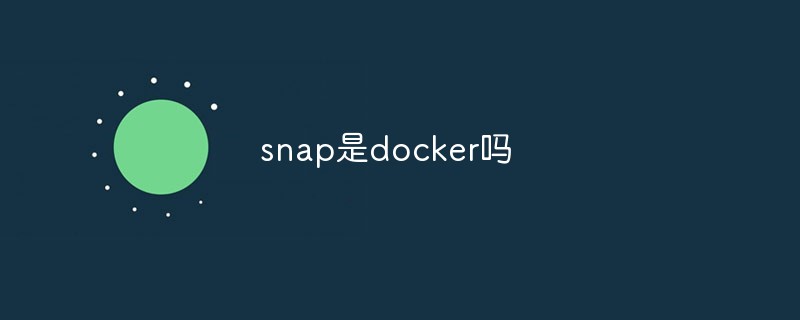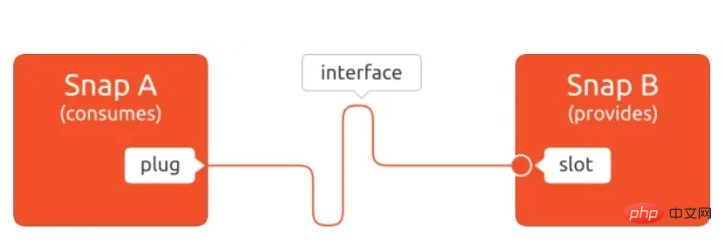Snap is docker?
Snap is not docker. Snap is a new application format package introduced when Ubuntu 16.04 LTS was released. Docker is an open source application container engine. Developers can use snap to install docker.

The operating environment of this article: ubuntu 18.04 system, Docker version 20.10.11, Dell G3 computer.
Is snap docker?
snap is not docker.
snap application introduction:
If you are using the Ubuntu 18.04/20.04 LTS version of the Ubuntu system, you will find that there is an additional application format package in the system— —.snap package.
Snap package is a new application format package introduced when Ubuntu 16.04 LTS was released. It is currently popular in Ubuntu and other Linux distributions such as Debian, Arch Linux, Fedora, Kaili Linux, openSUSE, Red Hat, etc. to install and use snap applications through snapd.
After you install snap, you will find that mount points such as /dev/loop0 will appear in the root directory. These mount points are the directories of the snap software package. Snap uses the squashFS file system, an open source compressed, read-only file system released under the GPL license. Once a snap is installed, it has a read-only file system and a writable area. The application's own executable files, libraries, and dependent packages are all placed in this read-only directory, which means that this directory cannot be tampered with or written to at will.
The introduction of the squashFS file system makes snap more secure than traditional Linux software packages. At the same time, each snap is strictly restricted by default, which limits system permissions and resource access. However, access to system resources can be gained through grant permissions policies. This is also a sign of better security.

#Snap can contain one or more services, supports cli (command line) applications, GUI graphics applications, and has no single process limit. Therefore, you can call one or more services under a single snap. This is very convenient for some multi-service applications. As mentioned earlier, snaps are isolated from each other, so how do they exchange resources? The answer is that resource exchange can be done through interface definition. The interface is used to allow snap to access OpenGL acceleration, sound card playback, recording, network and HOME directories. Interface consists of slots and plugs, namely providers and consumers.
Docker introduction:
Docker is an open source application container engine that allows developers to package their applications and dependencies into a portable image, and then Publishing to any popular Linux or Windows operating system machine can also be virtualized. Containers completely use the sandbox mechanism and will not have any interfaces with each other.
We can use snap to install docker in Ubuntu18.04.
Recommended learning: "docker video tutorial"
The above is the detailed content of Snap is docker?. For more information, please follow other related articles on the PHP Chinese website!

Hot AI Tools

Undresser.AI Undress
AI-powered app for creating realistic nude photos

AI Clothes Remover
Online AI tool for removing clothes from photos.

Undress AI Tool
Undress images for free

Clothoff.io
AI clothes remover

Video Face Swap
Swap faces in any video effortlessly with our completely free AI face swap tool!

Hot Article

Hot Tools

Notepad++7.3.1
Easy-to-use and free code editor

SublimeText3 Chinese version
Chinese version, very easy to use

Zend Studio 13.0.1
Powerful PHP integrated development environment

Dreamweaver CS6
Visual web development tools

SublimeText3 Mac version
God-level code editing software (SublimeText3)

Hot Topics
 1655
1655
 14
14
 1413
1413
 52
52
 1306
1306
 25
25
 1252
1252
 29
29
 1226
1226
 24
24
 How to exit the container by docker
Apr 15, 2025 pm 12:15 PM
How to exit the container by docker
Apr 15, 2025 pm 12:15 PM
Four ways to exit Docker container: Use Ctrl D in the container terminal Enter exit command in the container terminal Use docker stop <container_name> Command Use docker kill <container_name> command in the host terminal (force exit)
 How to copy files in docker to outside
Apr 15, 2025 pm 12:12 PM
How to copy files in docker to outside
Apr 15, 2025 pm 12:12 PM
Methods for copying files to external hosts in Docker: Use the docker cp command: Execute docker cp [Options] <Container Path> <Host Path>. Using data volumes: Create a directory on the host, and use the -v parameter to mount the directory into the container when creating the container to achieve bidirectional file synchronization.
 How to restart docker
Apr 15, 2025 pm 12:06 PM
How to restart docker
Apr 15, 2025 pm 12:06 PM
How to restart the Docker container: get the container ID (docker ps); stop the container (docker stop <container_id>); start the container (docker start <container_id>); verify that the restart is successful (docker ps). Other methods: Docker Compose (docker-compose restart) or Docker API (see Docker documentation).
 How to check the name of the docker container
Apr 15, 2025 pm 12:21 PM
How to check the name of the docker container
Apr 15, 2025 pm 12:21 PM
You can query the Docker container name by following the steps: List all containers (docker ps). Filter the container list (using the grep command). Gets the container name (located in the "NAMES" column).
 How to start mysql by docker
Apr 15, 2025 pm 12:09 PM
How to start mysql by docker
Apr 15, 2025 pm 12:09 PM
The process of starting MySQL in Docker consists of the following steps: Pull the MySQL image to create and start the container, set the root user password, and map the port verification connection Create the database and the user grants all permissions to the database
 How to start containers by docker
Apr 15, 2025 pm 12:27 PM
How to start containers by docker
Apr 15, 2025 pm 12:27 PM
Docker container startup steps: Pull the container image: Run "docker pull [mirror name]". Create a container: Use "docker create [options] [mirror name] [commands and parameters]". Start the container: Execute "docker start [Container name or ID]". Check container status: Verify that the container is running with "docker ps".
 How to update the image of docker
Apr 15, 2025 pm 12:03 PM
How to update the image of docker
Apr 15, 2025 pm 12:03 PM
The steps to update a Docker image are as follows: Pull the latest image tag New image Delete the old image for a specific tag (optional) Restart the container (if needed)
 How to view logs from docker
Apr 15, 2025 pm 12:24 PM
How to view logs from docker
Apr 15, 2025 pm 12:24 PM
The methods to view Docker logs include: using the docker logs command, for example: docker logs CONTAINER_NAME Use the docker exec command to run /bin/sh and view the log file, for example: docker exec -it CONTAINER_NAME /bin/sh ; cat /var/log/CONTAINER_NAME.log Use the docker-compose logs command of Docker Compose, for example: docker-compose -f docker-com




